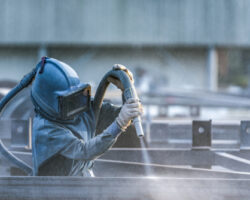Sandblasting: Tips and Techniques
 Sandblasting: Tips and Techniques
Sandblasting: Tips and Techniques
Sandblasting is a popular technique for removing surface materials, such as paint, rust, and grime, on a variety of materials. However, sandblasting can be a tricky and potentially hazardous process, requiring specific skills, equipment, and safety precautions. In this blog post, we’ll discuss tips and techniques for sandblasting that can help you achieve the results you want while minimizing risks.
First, let’s cover some basic sandblasting equipment and materials you’ll need. These include a sandblasting cabinet or booth (which contains the sandblasting area and prevents dust and debris from escaping), a sandblasting gun (which blasts sand or other media at high pressure), abrasive media (such as sand, glass beads, or steel shots), and a compressed air source. Safety equipment is also crucial, including respirators, eye and ear protection, and protective clothing.
Tip #1: Choose the Right Abrasive Material
The type of abrasive media you choose will depend on the material being blasted and the desired result. For example, if you’re removing rust from a metal surface, you might use steel shots or grits. If you’re cleaning a softer material, such as wood or plastic, you might use glass beads or walnut shells. Which abrasive media to choose will also depend on the surface finish you want to achieve. Fine media like glass beads will produce a smoother surface, while more coarse media like steel shots will leave a rougher finish.
Tip #2: Adjust the Sandblasting Pressure and Distance
The pressure and distance of the sandblasting gun are critical factors in achieving the desired result. If the blasting pressure is too high or the gun is held too close to the surface, you can damage the material or leave scars. Conversely, if the blasting pressure is too low or the gun is held too far away, you may not achieve the desired result. It’s important to adjust the pressure and distance based on the material being blasted and the abrasive media being used.
Tip #3: Pay Attention to the Direction of the Media Spray
When sandblasting, it’s important to pay attention to the direction of the media spray. Avoid spraying directly at corners or edges, as this can cause the material to become deformed or damaged. Instead, aim the spray at a 45-degree angle to the surface being blasted. This will help ensure that the abrasive media is evenly distributed and doesn’t become concentrated at any one point.
Tip #4: Use the Correct Nozzle Size
One of the most important factors in achieving the desired result is choosing the correct nozzle size for your sandblasting gun. The nozzle size will determine the amount of abrasive media that is being blasted and the pressure at which it is being delivered. A nozzle that is too small will cause the abrasive media to clog, reducing the blasting power, while a nozzle that is too large will waste media and result in uneven coverage.
Tip #5: Clean Between Abrasive Media Changes
If you’re switching between different abrasive media, such as switching from sand to glass beads, it’s important to thoroughly clean the sandblasting cabinet and gun between changes. This will help prevent cross-contamination of the media and ensure that you get the desired finish. Failure to clean between changes can result in a build-up of residue that can clog the media delivery system and cause inconsistent results.
Technique #1: Blasting in a circular motion
Circular blasting is a helpful technique for sandblasting surfaces with low profile and curves. To do this technique, you need to make sure that the sandblasting gun is constantly moving in a circular motion, keeping the nozzle at a steady distance away from the surface, while also applying consistent pressure.
Technique #2: Wet Sandblasting
This technique is considered one of the safest methods of sandblasting, and it’s ideal for metals that are vulnerable to heat. Wet sandblasting is done using a mixture of water, abrasive material, and compressed air. It helps in reducing the temperature of the surface, which prevents the metal from getting damaged.
Conclusion
While sandblasting can be a hazardous process, with the right equipment, materials, and techniques, you can achieve the desired results safely and efficiently. Remember to choose the right abrasive media, adjust the sandblasting pressure and distance, pay attention to the direction of the media spray, use the correct nozzle size, and clean between abrasive media changes. By following these tips and techniques, you’ll be able to tackle any sandblasting project with skill and confidence.
Got questions about sandblasting? Let us help! Be sure to contact our team of heavy equipment specialists here at Ram Rent-All, Inc. to learn more about what we can do for you!
